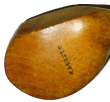
|
Registration Edit profile catalogue auction shopping cart shipping history makers search faq news links about contact |

Scottish Golf History
PlacesGleneagles: Birth of the Ryder Cup(Source: © 1999 - 2022, Douglas MacKenzie) In 1910 Donald Matheson, the general manager of the Caledonian Railway, spent a pleasant holiday in Strathearn. So taken with the place was he, that he decided to build a luxury hotel in the area. James Miller, who was also responsible for the Turnberry Hotel, was appointed architect and work on the building began in 1913. The hotel was due to open at Easter 1915 but progress was halted by the First World War and it was not until 1924 that the hotel opened its doors. During this time the company set up to develop the hotel, the Gleneagles Hotel & Golf Courses Ltd (later truncated to Gleneagles Ltd) struggled and completion of the hotel was only achieved by the Caledonian railway taking over all development in December 1922. The advertisement is from National Geographic in 1925: even then it was firmly focussed on the North American market. For all the opulence with which Gleneagles is now associated, it is interesting to note that for the first ten years or so of the hotel's existence, the Haldane family, who owned the nearby Gleneagles estate, fought a vain battle to ensure that the hotel management always referred to their establishment by its full title of the Gleneagles Hotel. After all, they did not wish their estate confused with something as downmarket as a 'modern railway hotel'. Development of the golf course was speedier. James Braid and Major C K Hutchison visited the area in December 1913 and, the following April, were appointed to design and supervise the course construction for a fee of £120 plus expenses. The work was done by Carters the seed merchants at a cost of £5500. The King's Course and the Queen's, initially a 9-holer and intended as a ladies' course, were completed by the end of the War.
The King's opened officially in May 1919 and the first professional tournament was played there in 1920 and won by the pro at Turnberry, Tom Fernie. The map of the course is from 1921.
As with any development there were plenty complaints. A resident of Glendevon told the central district committee in Crieff in October 1922 that ‘they could get a cattle beast into some of the holes on the road. The whole trouble was the Gleneagles golf course. The number of cars going down to Gleneagles was something terrible’. The councilors listened politely and did what councilors do and referred the matter to another committee. Bernard Darwin, writing in 1947, makes some gently disparaging remarks about the course. 'The beauty of the course is beyond all question; the exact merits of the course perhaps more difficult to decide ... The ground hardened miraculously under the constrant tread of the human foot and .... that which was once a tail-twisting test for tigers has turned into very good and jolly holiday golf for those who do not mind a little hill-climbing. It has names for its holes of such deperate Scottiscism ... American golfers always deem it a paradise and if I do not quite share that view I readily admit that, in mild and prosaic language, it is a very pleasant place to play golf.' In the same book he discusses the Ryder Cup but does not mention Gleneagles' role in that competition. He mentions the informal match between Great Britain and the United States at Wentworth in 1926 (which GB won by 13½-1½) but a similarly one-sided match took place at Gleneagles on 6 June 1921. The course's designer, James Braid, beat Clarence Hackney 5 & 4 in he singles and, playing with J H Taylor, halved against Hackney and the US Open Champion of 1908, Fred McLeod. The final score was 9-3 in the home team's favour. This international was a preamble to the main event, the Thousand Guineas Golf Tournament, which featured twelve players from Scotland and England, twelve from the USA, Joe Kirkwood from Australia and Arnaud Massy. After the qualifying strokeplay the matchplay was won appropriately by Abe Mitchell (who was the model for the golfer atop the eventual Ryder Cup trophy), defeating Kirkwood in the final.
This tournament had started the previous year, sponsored by the Glasgow Herald newspaper with the largest prize in British Golf of £650. It was played at Gleneagles from then until 1927 with the prize money increased to 1000 guineas in 1921 hence the popular name for the tournament. The London Midland and Scottish Railway Company also initiated an annual amateur tournament at the course in 1925. This carried on from the amateur tournament tacked on to the end of the professional competition and first won in 1920 by Tommy Armour.
If you wonder what sort of eagles you will see in the glen unless they are on your scorecard you will be disappointed. Contrary to the logo used by the hotel the derivation of the name is an anglicisation of Gaelic glen eaglais, the glen of the church. |
site design dmc ltd | © 2000-2024 Antique Golf Clubs from Scotland



